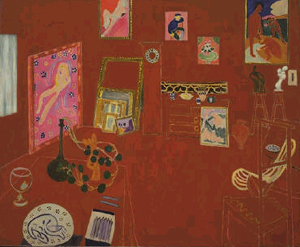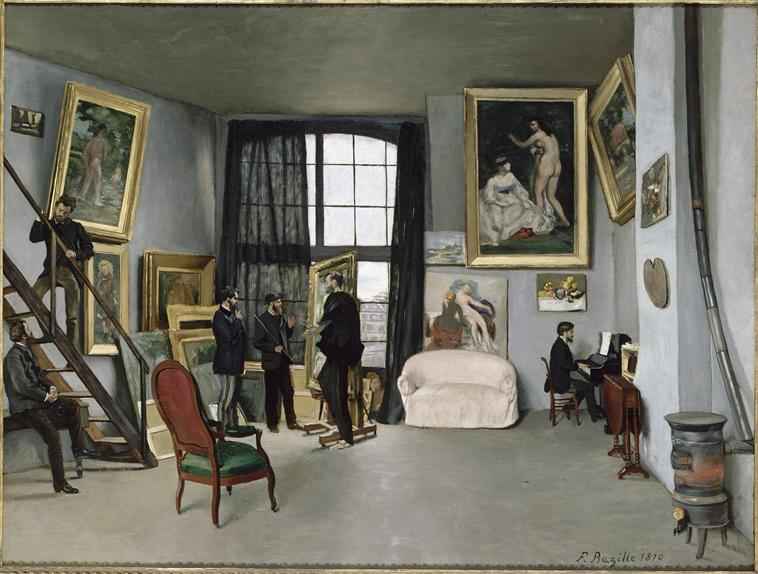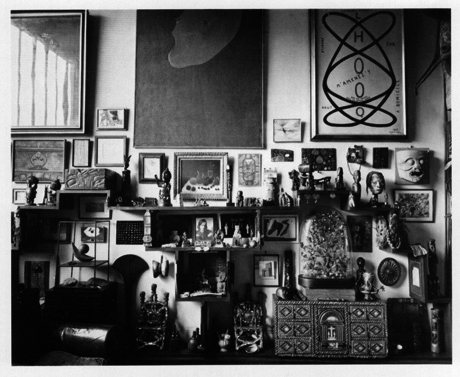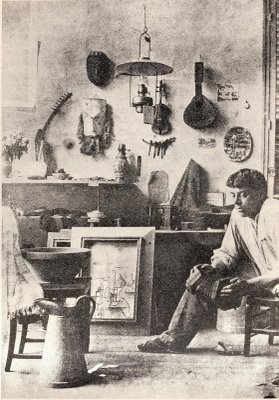Interview with Franck Leibovici (continuation)¹ by Grégory Castéra (translated by David Pickering)
1.
franck leibovici …in each of these images you’ve laid out in front of us the atelier is shown differently: matisse depicts some objects on a table and others hanging on the wall; braque does the same but adds a figure engaged in some sort of leisurely, secondary, but no doubt complementary activity; bazille, on the other hand, populates his work space with individuals—probably friends of his—going about various tasks (one plays the piano, others discuss serious business, and so on). the issue of the atelier you are bringing up here is interesting but i sense that it doesn’t completely coincide with “forms of life,” for the atelier immediately suggests the production cell, while the notion of ecosystem strives to break free of its production-exhibition-contemplation sequence. on the other hand, it could be amusing to consider which forms of life these images of workshops imply. the question of whether one turns it into a solitary space or, on the contrary, a social one, is telling. empty it out or fill it with people: two forms of work that sometimes overlap.
Grégory Castéra I showed you these images because it seems to me that the theme of the artist’s atelier, because of the wide range of documents and works it includes, is what is popularly expected from a behind-the-scenes production of an artwork and the representation of an artist’s life. It was in high school that I discovered this photo of André Breton. It conjured up a certain idea of the “cultured man.” I interpreted the collection in the background as an allegory of the knowledge accumulated over a lifetime—a mix of cultures, noble materials and refined taste. Like a library, the collection is an archetypal representation of a form of life², as much in its composition and organization as its uses. But for your project it strikes me as more interesting to know how the collection was amassed. Though I knew strictly nothing about Breton, I imagined him as a decisive man who asserted his opinions in public, a misogynistic charmer with a personal fortune sufficient to allow him to travel, buy artworks, live in a nice apartment and have to answer to almost no one…
fl …when the truth is his rue fontaine apartment was quite modest, and many of the objects were acquired at drouot (a Parisian auction house, Tr.), and had very little monetary value at the time. 
Henri Matisse, L'Atelier rouge, 1911.

Frédéric Bazille, Edouard Manet, L'Atelier de Bazille, 1870.
Sabine Weiss, L'Atelier d'André Breton, 1960
Atelier de Georges Braques
2.
GC Among the answers we receive, some artists propose works, others documents. How do you take into account the status of propositions in your survey?
fl it was not I but certain artists who created this artwork / document division. once again, what is being asked for is an invention of forms of representation. in that respect, the survey deals with a poetic question, in the etymological sense of “the creation of a form” (poiein). in order to be relevant to this survey a response must invent a form. in my opinion, its status therefore comes prior to the artwork / document distinction.
GC Yesterday, we met with ______. He said that his contribution to the survey would be textual. Furthermore, he distinguishes his works (which are mainly installations and sound pieces) from the documents he publishes in book form. You told him that, to represent a form of life, the techniques the artist masters may prove more appropriate than texts. Though the text is conventionally recognized as the principal technology of discursivity, you assert that “a painting can be a theoretical proposition.” It might be useful to explain the controversy to which this assertion refers.
fl yes, texts or conversations are tools that are traditionally mobilized to contextualize, place, or categorize an artwork. at a gallery opening, it is not uncommon to see an artist give a guided tour of the exhibit or pen a text that functions like a statement of purpose. but i am more interested in an artist who uses the tools of his trade, the same ones he uses for his practice, to try his hand at the representational invention being asked for. i am not looking for a causal explanation of artworks, nor am i looking for commentaries on artistic practices. it would have been altogether possible to ask an art sociologist to study the practices of a group of artists, and to deliver an analysis. but this is not what i’m looking for. it is not only important for me to ask the studied group’s indigenous members to represent their respective cosmogonies—i am also trying to avoid meta-language as much as possible in this representational work. that is why the request is so difficult: the artists are being asked to use the tools that constitute their practice, to produce representations of their ecosystem. in no way are we asking them to return a commentary on their practices that is meta- (“documentation” or the para-).
GC Still, it seems to me that producing the representation of an ecosystem could come close to a meta-language. In other words, producing a language that consists of speaking about the language itself.
fl not at all. meta- implies a distance, and a difference in altitude (we place ourselves just above). here, the re-description happens from within. the vocabulary used is none other that that ordinarily utilized by the artist each day. when we are in the middle of things, we can survey the territory, and describe what we see, but we will never try to exteriorize, or step outside ourselves. that would be like trying to grab oneself by ones own hair.
the project asks for an effort at inventing representations. there is always the fear that answering with a text or a conversation might only meet the requirements of part of the survey, the content part, while leaving out the question of form. unless of course the artist thinks of the conversation or the text as one of his or her practices, as is the case with david antin³ for example. this is the opposite of a survey in which you give answers in the form of statements. unfortunately statements are no help at all because they function in something of a meta- mode. in terms of an utterance, the statement expresses the subjectivity of an “i”. “i think that…” (generally followed by an expression of indignation). instead, the notion of “form of life” tries to shed a rather simplistic “i” and to construct a somewhat more articulate collective utterance. we need maps, not statements.
GC So a painting can be a theoretical proposition because it can be more useful than a text for charting a practice.
fl a painting or anything else. yes, a painting can function as a theoretical proposition. we must distinguish the mode of written expression (theoretical, creative, informative) from the format used (scholarly article, handbook, vacation book). even though the two are habitually lumped together (it is mainly in scholarly articles that we are used to finding theoretical writing), we benefit from differentiating them because it gives us greater freedom of action. a mode of writing can lend itself to different mediums, different formats, different platforms, just as a format (medium, platform) can accommodate different writing modes. jean-luc godard puts it very nicely in his early texts when he says that, at the cahiers du cinema, he made movies, but with paper and a pen, and that later he continued to theorize, but with a camera.
GC In other words, if I went back to your earlier remarks about meta-language, and painting as a theoretical proposition, there would be a misunderstanding about what we consider theory.
fl poets or artists often make much of their refusal to “theorize on” their practice. obviously if we were asking them to lay it on thick, or produce a wordy commentary intended to add value to a work, that would be understandable. but maybe there is a misunderstanding about what theory is, maybe it’s a preposition problem—theory isn’t “about” but “in” or “within,” it is concomitant with practice. they are two sides of the same coin. moreover, quite often, these same artists elaborate their practices based on a very clear “theoretical position”: they know exactly what they are doing, they refuse a certain number of things, and develop a clear direction. but that initial refusal disappears when they stop talking about, and begin surveying, a territory. in fact, we might almost say that their practice fashions their theoretical position. in emmanuel hocquard’s title, “theory of tables”⁴, we get a clear sense that the theory is not of a meta- order: “theoria” means contemplation. why “tables”? a table is a platform, it is what allows us to set things down: without a base, without a platform, objects would fall to the ground and crumble. a table is definitively what allows us to see things, to put several of different natures side-by-side. thus the table becomes a visualization technique. a “theory of tables,” is what we do when we ask ourselves how to display objects, how to make things visible which so far don’t have a frame, how to stabilize them. tables offer another scale with which to define other frames of perception. theory only has very little to do with the meta, it deals above all else with questions of scale.
3.
GC A large part of the work with the team at Les Laboratoires d’Aubervilliers and the artists that participate in the survey consists of explicating the lexicon we use—“forms of life,” “ecology of a practice,” etc. The application of these terms to a field in which they don’t belong falls under the definition of what Nelson Goodman called “metaphor.”⁵ For Goodman, a metaphor is linked to a set of uses, and can therefore only be designated for a given period. In that sense, the job of explicating, which we are laboring at in the ordinary stories, seems to me to correspond to a “de-metaphorization.”
fl i agree completely. we should look at this project as an attempt to literalize the expressions “forms of life” and “ecosystem”: these terms are not yet “implanted” in current usage, but they could prove very useful for changing some things, or escaping certain aporias. the job of re-description asked of the artists, which consists of giving an account of their daily routine, literalizes what could have formerly been considered as metaphorical.
in that respect, de-metaphorizing and literalizing (in other words, describing) means proposing a new lexicon and, as a direct result, if this new lexicon is used, our habits of vision or action (our beliefs) are altered. suddenly, the objects change scale and format, the reference points are no longer the same—it is no longer only the exhibited artifact that is grasped, but a much larger whole that is given a new name. it’s something like what we were saying in our last discussion: what is ultimately aimed for is the modification of frames of perception of what we call an artwork. and so it becomes impossible to distinguish the political dimension of the project from questions of the ontology of art.
GC In a few words, this modification of frames of perception brings out the types of collectives an art practice might engender—in terms of composition, temporality, dynamics of exchange, renewing membership, and so on. The artworks do as much to form the collective, as the collective does to form them. Is the model that articulates the functions of production/creation and reception/interpretation still operating in the context of forms of life? And how should the idea of artistic discipline be addressed through forms of life?
fl you suggest a very nice formulation there: “this modification of frames of perception brings out the types of collectives an artistic practice engenders.” let’s say that the creation/interpretation model is forking out. the moment when you start linking artworks to the collectives they engender, it becomes difficult to distinguish an audience from a producer, for the participants of a collective are willing partners in the project—whether directly or indirectly—and are, at the same time actors and receivers. they form the project’s “audience.” whoever is able to see the types of collectives an artistic practice engenders, thereby gaining a sort of gestaltist ⁶ ability, will continue to interpret the artworks, but his interpretation will no longer be based on the same groupings.
GC And what of the disciplines?
fl they are one of the producer-impetuses of the “forms of life,” for they are linked to this question of practice, of training and asceticism. actually it is amusing to note that in English when we “practice” doing something, we are also training ourselves to do it. this is true in sports, art, religion and politics.
4.
GC Asking artists to produce visualizations that represent forms of life implies that they chose what they want to emphasize, thus closing off a set of parameters that might be considered as the minimum conditions for contextualization. For example (I am voluntarily exaggerating the criteria): birth place, work space(s), religion and religious culture, political sensitivity, gender, sex, sexuality, income, the portion of this revenue allocated toward consumption, travel, or reinvested in work (very important for certain artists whose practice is linked to new technologies for example), basic and higher education, peers who have had an influence, relationship to the media and to culture in general, other practices (hobbies, day jobs), and so on. In short: what are the criteria for a valid response?
fl yes, it’s true. the survey doesn’t resemble patrick sabatier’s jeu de la verité (TV show in which stars tell all, Tr.). we aren’t trying to get a scoop, or to violate anyone’s privacy. artists will emphasize whatever aspects they deem fit. this requires a great deal of honesty on the part of the artist, for someone who gets by with a smart quip will be of no help at all. on the other hand, accepting indigenous representations also means not evaluating the responses based on outside criteria, or trying to list all of the criteria that might play a role in order to systematically apply them to each case. it is the group in question that decides what tests to put into place to evaluate whether or not an answer is worthwhile, not a set of criteria drawn up beforehand by a ministry or university that tries to judge the relevancy or efficiency of answers. we must therefore wait to see if they help change things or opinions, or whether they just renew the status quo.
trusting artists in their choice of what should be emphasized also means leaving behind a critical posture that would seek to discover the true mechanisms hidden underneath the art world, and which preside over its real functioning, in order to better denounce them. i was going to say: if they are honest, artists know what they’re doing when they answer in a given way. but in the end I’ll say this: if they are attentive enough, they will succeed in describing what they do with precision (instead of saying what they think they do). before completing this type of exercise, we don’t know exactly what we do, not because we act unconsciously, but because we automate our routines and, as a result, we make them invisible. in other instances, we frame certain gestures as preliminary to others, when they should be described for themselves.⁷
5.
GC Now that most of the responses to the survey have come in, how will you go about analyzing the data?
fl last week we began to “peel back” the first responses. directors of les laboratoires d’aubervilliers were present, alice chauchat, nataša petrešin-bachelez and you, as well as virginie bobin, who coordinates the projects, claire harsany who is office manager, and anne millet who is communications director. we looked at responses one after another. when one of us knew a little more than the others about the artist in question, he or she tried to contextualize the response. we read these contributions in light of what the conversations added, because, of course, an image doesn’t speak for itself. it was a very enriching, though quite ordinary reading or viewing experience: seeing how a group enters into a decoding enterprise.
this is the job we have been tackling throughout july and august. we’ll see what public outcome is the most pertinent.
GC Though we were able to contextualize some artists’ propositions, we were far from experts on a good many of them. Is this lack of information a problem for certain responses? Can the inaccuracy of our knowledge be of use to you or is it better to meet specialists?
fl that’s a difficult yet central question for this project because it poses the problem of expertise. on the one hand, an image can’t speak for itself. so, indeed, the better we contextualize it, the better we will understand its functioning in the environment for which it was intended. in this sense, the problem of the status of responses, the way we grasp them, is the same as when we are standing in front of an artwork.
at the same time, these responses are meant to allow a different mode of comprehension of the artist’s work, a change of scale. they must therefore allow the works of the artist in question to function differently. which means that we have two possible uses for the responses we are in the process of receiving: either we attach them to a body of pre-existing works and we see how they modify the perception of the whole, or we try to make them function on their own. the first use aims to modify the questions we ask ourselves about an exhibited work or add new ones (what form of life can a given work produce or what form of life is engendered by a given practice). the second use deals specifically with the question of the invention of forms of representation of something we don’t yet know how to represent. in the first case, we’ll be attentive to what is said, and it is during this process of interpretation that we can ask the question of expertise. in the second case, we’ll focus our attention on the plastic character of the response.
obviously, the two uses are not totally dissociable, they feed into one another. but there is always this utopian vision of the tool, which consists of thinking that, for the second case, the invented form might circulate and be applied to other works. we fluctuate between two conceptions of the response: on the one hand, the autonomy and self-sufficiency of its plasticity predicated on the hope that, if it succeeds, it might become almost an “intellectual technology”⁸, a format of description for a new scale; on the other hand, a response-prosthesis, which, when added in a particular way to a specific body, produces a new whole, a new definition of the artwork. in the first case, we dream of a public circulation of tools, in the other, the extension of what we call “artwork” is always achieved through the ad hoc and cannot truly be generalized.
if i wanted to be hard on myself, I would almost say that we find the same traditional tension between singularity and universality here as in the modernist artwork, albeit in very different terms and through very different means.
Interview published in Le Journal des Laboratoires, Sept-Dec. 2011
¹ During the previous interview (Journal des Laboratoires, May-August 2011), Grégory Castéra and Franck Leibovici discussed different aspects of the notion of “forms of life,” the sustainability of a practice with collective formations, the project’s public stakes and the redefinition of the resulting work.
² One may recall, notably, the libraries of Jean-Luc Paran, Yann Sérandour, Martha Rosler and Jean-Yves Jouannais, which were made pubic, exposed, bartered, discussed, etc.
³ David Antin improvised talk poems that intermingled narrative, conference, anecdote, monologue, meditation and philosophical dialogue. It was said of him that he was a “a mix of Mark Twain and Gertrude Stein,” or “a cross between Lenny Bruce and Ludwig Wittgenstein.” (Source: Les Presses du Réel)
⁴ Emmanuel Hocquard, Théorie des tables, POL, Paris, 1992.
⁵ For Nelson Goodman (Languages de l’art: Une approche de la théorie des symboles. Editions Jacqueline Chambon. Nice, 2005) metaphor consists of implementing (in other words, activating) a notion in a context which is foreign to it. the transfer of a “kingdom” toward another occurs by the selection and emphasis of certain labels. If a man is qualified as a “bulldozer” it is generally the idea of “strength” that is mobilized. But predicates that are commonly placed in the background can, in certain situations, re-motivate the transfer—move forward unwaveringly in a straight line, have treads in place of tires, etc. (apply this bull image to a long-distance runner and see what emerges). The literalization of the expression “forms of life” therefore not only poses the question of the modalities of implementation of the expression, but especially those of its implantation (to borrow an expression from Olivier Quintyn): “a metaphor is, first or logically, an operation of (lexical and cognitive) implantation. But if it ‘succeeds’ or if it simply produces effects, it can be re-implanted or modify the implantations of predicates or its associated concepts.”
⁶ Born in the early 20th century, gestalt theory is situated at the intersection between the psychology of perception and phenomenology. It aims to uncover laws that allow us to perceptually grasp forms. Against an essentialism or idealism that would see these as existing by themselves, gestalt theory considers that the subject and object conjointly emerge through action.
⁷ A bit like in psychoanalysis when the issue is not knowing whether the patient is telling the “the truth” about the facts, but to understand what representations he or she is establishing. Or, furthermore, in ethnology, when one asks a studied group to reconstruct its cosmogony without asking if the ritual dance being described actually makes it rain according to the criteria of our modern sciences.
⁸ The term “intellectual technology” is borrowed from the work The Domestication of the Savage Mind (Cambridge, Cambridge University Press, 1977)


